| #1 Application of the Night Guard using Magnetic attachment on a Patient with Bruxism |
||
| S.Kamogawa1, N.Tsukimura1,2, M.Morokuma1CN.Suzuki1, Y.Takeuchi1, S.Ohno1, T.Azuhata1, Y.Abe1, T.Ishigami1,2 | ||
| 1 Department of Partial Denture Prosthodontics, Nihon University School@of Dentistry, Japan 2Division of Clinical Research, Dental Research Center, Nihon University School@of Dentistry, Japan | ||
| Introduction |
| As handing of a removable denture, most of dentists usually instruct a patient that a denture should be removed overnight. However, on patient with bruxism, dentures are recommended to wear for protecting teeth occasionally.@Meanwhile, in spite of proposing to use dentures while asleep, bruxism may be caused in fracture of dentures repeatedly. One clinical case is to apply the night guard using magnetic attachment for a patient with hard bruxism while asleep. |
| Case |
 |
| Figure 1 shows oral cavity. The patient was a 68-year-old male.@ The copings with post keeper were set at the No.12,@17,@21,@22 and 23,@which@were formed concave due to lack of clearance except No.17. The No. 35-44 dentition (9 anterior teeth) was connected by resin facing cast crown. Maxillary right incisor (No.11) that was un-extractive owing to high blood pressure was remained. |
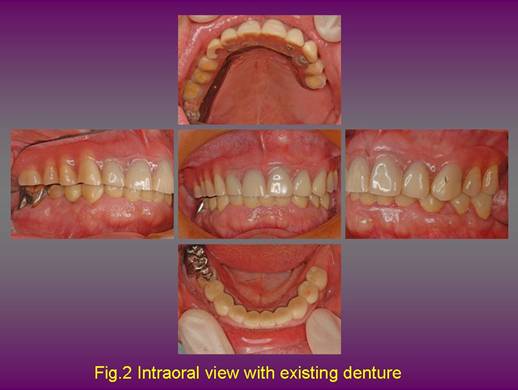 |
|
| Figure 2 shows an existing denture we made recently in maxillary. This denture was not extended on No.26 and 27 spaces because of missing teeth (No.36 and 37) in mandible. A metal denture frame was designed in non-palatal type and was attempted in the housing metal method for serving comfortableness to wear and increasing strength to avoid the fracture of denture repeatedly. |
|
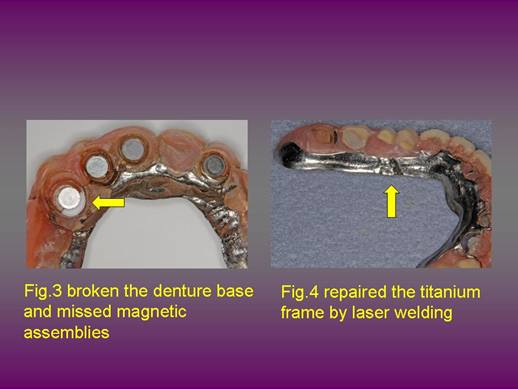 |
|
| Figure 3 and 4 shows the old denture which was used while asleep. Some
big problems were caused by old denture which was wore as a night guard
while asleep, that were to over-attrite and break the artificial tooth,
to miss the magnetic assemblies, and to damage the titanium frame occasionally.@ Also, in mandible some anterior teeth were chipped the covered hard resin away repeatedly. The soft night guard was tried to apply over the mandible dentition. However, the patient rejected to wear due to feeling uncomfortable and sleeping problems. |
|
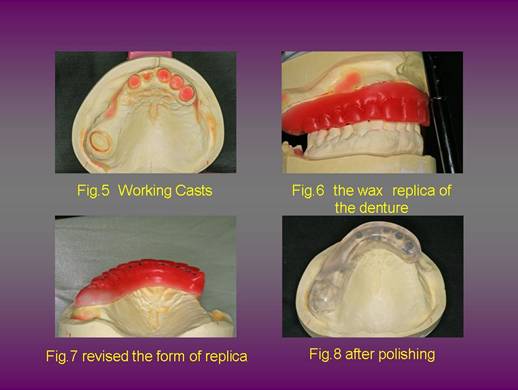 |
|
| After taking impression as the denture production procedure, the working cast was fabricated (Fig. 5). The night guard was took a registration of interocclusal relation using the replica of the new denture, so that was obtained similar occlusal vertical dimension (Fig.6). After the working cast was mounted on the articulator, the replica was revised to the form of the sprint, and then the core of the splint was taken by putty type of silicone impression material (Fig.7). The night guard using magnetic attachment was made by transparent acrylic denture base resin (Palapress vario, Heraeus Kulzer). The acrylic resin was injected into the core on the working cast and polymerized in the Palamat practice pressure curing unit 55 and 2 bars pressure for 30 min. The product was polished in the ordinary method (Fig.8). | |
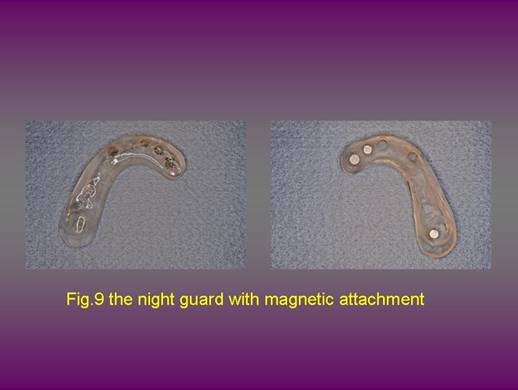 |
|
| Figure 9 shows the night guard with magnetic attachment. The 5 magnetic assemblies were set on the corresponded keeper position into the night guard using quick self-curing acrylic resin (ORTHOFAST, GC) in oral. An outward form of the finished night guard was considered as similar as possible to that of the existing denture, under condition of the acceptable apparatus for patient. |
|
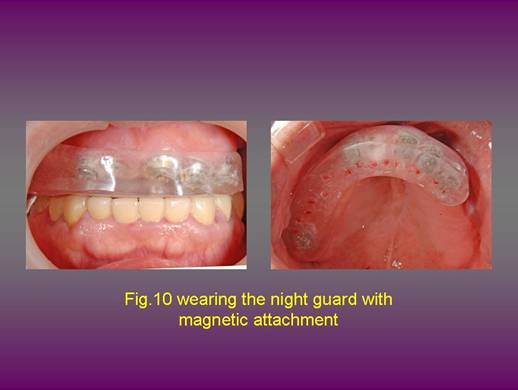 |
|
| Figure 10 shows the night guard with magnetic attachment. All functional cusp in centric occlusion were adjusted to a point contact for avoid occlusal interference. | |
| Comsideration |
| In clinical situation we often have a hard opportunity to
find an advantageous treatment. This result showed the night guard that
we provided in this case was undergoing at the good condition for 6 months
and also was obtained the fully satisfaction for the patient. However it
is necessary to follow up more long-term progress. In conclusion, the night
guard with magnetic attachment was useful for patients with bruxism, who
wore an overdenture using magnetic attachments. Therefore the magnet attachments
may have various possibilities to apply in complicated prosthetic case.
|
| References |
| 1. Y. Komasa, E. Nagai, K. Sugikami, and Y. Shiina, Dental Technology of Denture : 235-237, Ishiyaku Publishers, Inc., Tokyo, 2007 2. S. Endo, T. Ishigami, K. Miyata, H. Toyoma, M. Tsuyumu, and T. Azuhata, Hardening time of self-curing resin for installing magnets and removing denture, JJ Mag Dent, 18 (2 ) : 46-49, 2009, 3 |